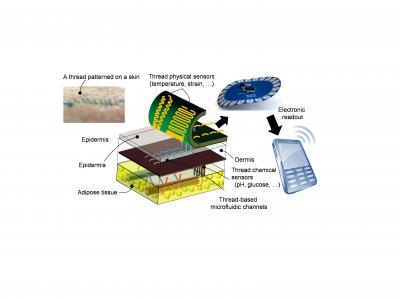‘Smart thread’ collects data wirelessly while doctors stitch patients
Engineers have now figured out a way to integrate nano-scale sensors, electronics and microfluidics into threads like cotton and even sophisticated synthetics, that could be sutured through multiple layers of tissue in order to gather diagnostic data wirelessly in real time.
What the Tufts University engineers have created is a possible new thread-based diagnostic platform, which could lead to a new generation of implantable diagnostic devices and smart wearable systems.
The researchers used different types of conductive threads that were dipped in physical and chemical sensing compounds and connected to wireless electronic circuits to create a flexible platform that they were able to suture into tissue in rats, as well as in vitro.

While testing the threads, they were able to collect information regarding tissue health, such as pressure, stress, strain and temperature, as well as pH and glucose levels that can be used to determine how well a wound is healing, whether infection is emerging, or whether the body’s chemistry is out of balance. The results were relayed to a cell phone and computer.
The team’s new platform can conform to structures like organs, wounds or orthopedic implants.
The smart thread is not quite a finished product yet. The researchers will now need to determine long-term biocompatibility, but for no the researchers say that their initial results have the potential to optimize patient-specific treatments.
“The ability to suture a thread-based diagnostic device intimately in a tissue or organ environment in three dimensions adds a unique feature that is not available with other flexible diagnostic platforms,” said Sameer Sonkusale, Ph.D., corresponding author on the paper and director of the interdisciplinary Nano Lab in the Department of Electrical and Computer Engineering at Tufts University’s School of Engineering. “We think thread-based devices could potentially be used as smart sutures for surgical implants, smart bandages to monitor wound healing, or integrated with textile or fabric as personalized health monitors and point-of-care diagnostics.”
According to Pooria Mostafalu, Ph.D., one of the paper’s author’s, thread acts as a great way to implement this technology.
“Thread is abundant, inexpensive, thin and flexible, and can be easily manipulated into complex shapes,” said Mostafalu. “Additionally, analytes can be delivered directly to tissue by using thread’s natural wicking properties.”

Comments are closed, but trackbacks and pingbacks are open.